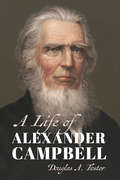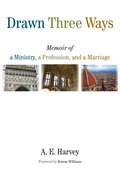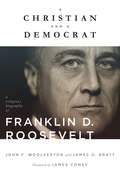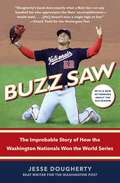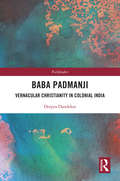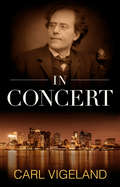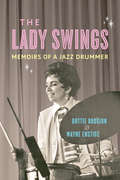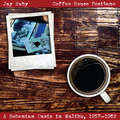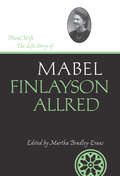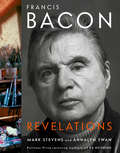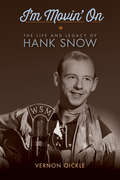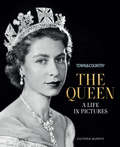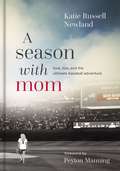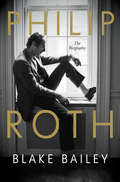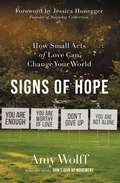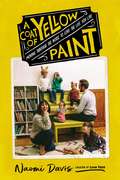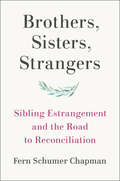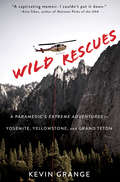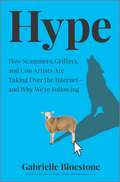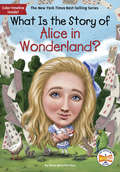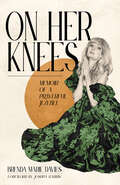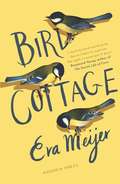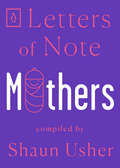- Table View
- List View
A Life of Alexander Campbell (Library of Religious Biography (LRB))
by Douglas A. FosterThe first critical biography of Alexander Campbell, one of the founders of the Stone-Campbell Movement A Life of Alexander Campbell examines the core identity of a gifted and determined reformer to whom millions of Christians around the globe today owe much of their identity—whether they know it or not. Douglas Foster assesses principal parts of Campbell&’s life and thought to discover his significance for American Christianity and the worldwide movement that emerged from his work. He examines Campbell&’s formation in Ireland, his creation and execution of a reform of Christianity beginning in America, and his despair at the destruction of his vision by the American Civil War. A Life of Alexander Campbell shows why this important but sometimes misunderstood and neglected figure belongs at the heart of the American religious story.
Drawn Three Ways: Memoir of a Ministry, a Profession, and a Marriage
by A. E. HarveyMoving reflections from an influential Anglican pastor, theologian, and teacher In this compelling memoir Anthony Harvey traces the three ways he has felt drawn throughout his life — to a ministry in the Anglican priesthood, to a profession in theological scholarship, and to his marriage and family. Harvey recounts his training of clergy in Canterbury, his time as canon of Westminster Abbey, his teaching and research at the University of Oxford, and his many exciting travels. He also candidly discusses the challenges presented by his marriage to an artist and writer whose spells of mental illness, along with the premature death of their daughter, placed great strain on both his family life and his public responsibilities. Throughout the book Harvey authentically narrates his inner tensions and conflicts, his own spiritual questioning, and his propensity toward a Christian stoicism.
A Christian and a Democrat: A Religious Biography of Franklin D. Roosevelt (Library of Religious Biography (LRB))
by James D. Bratt John F. WoolvertonFranklin Delano Roosevelt, when asked at a press conference about the roots of his political philosophy, responded simply, &“I am a Christian and a Democrat.&” This is the story of how the first informed the second—how his upbringing in the Episcopal Church and matriculation at the Groton School under legendary educator and minister Endicott Peabody molded Roosevelt into a leader whose politics were fundamentally shaped by the Social Gospel. A work begun by religious historian John Woolverton (1926 2014) and recently completed by James Bratt, A Christian and a Democrat is an engaging analysis of the surprisingly spiritual life of one of the most consequential presidents in US history. Reading Woolverton&’s account of FDR&’s response to the toxic demagoguery of his day will reassure readers today that a constructive way forward is possible for Christians, for Americans, and for the world.
A Christian and a Democrat: A Religious Biography of Franklin D. Roosevelt (Library of Religious Biography (LRB))
by James Bratt John WoolvertonFranklin Delano Roosevelt, when asked at a press conference about the roots of his political philosophy, responded simply, “I am a Christian and a Democrat.” This is the story of how the first informed the second—how his upbringing in the Episcopal Church and matriculation at the Groton School under legendary educator and minister Endicott Peabody molded Roosevelt into a leader whose politics were fundamentally shaped by the Social Gospel. A work begun by religious historian John Woolverton (1926 2014) and recently completed by James Bratt, A Christian and a Democrat is an engaging analysis of the surprisingly spiritual life of one of the most consequential presidents in US history. Reading Woolverton’s account of FDR’s response to the toxic demagoguery of his day will reassure readers today that a constructive way forward is possible for Christians, for Americans, and for the world.
Buzz Saw: The Improbable Story of How the Washington Nationals Won the World Series
by Jesse DoughertyThe remarkable story of the 2019 World Series champion Washington Nationals told by the Washington Post writer who followed the team most closely.By May 2019, the Washington Nationals—owners of baseball&’s oldest roster—had one of the worst records in the majors and just a 1.5 percent chance of winning the World Series. Yet by blending an old-school brand of baseball with modern analytics, they managed to sneak into the playoffs and put together the most unlikely postseason run in baseball history. Not only did they beat the Houston Astros, the team with the best regular-season record, to claim the franchise&’s first championship—they won all four games in Houston, making them the first club to ever win four road games in a World Series. &“You have a great year, and you can run into a buzz saw,&” Nationals pitcher Stephen Strasburg told Washington Post beat writer Jesse Dougherty after the team advanced to the World Series. &“Maybe this year we&’re the buzz saw.&” Dougherty followed the Nationals more closely than any other writer in America, and in Buzz Saw he recounts the dramatic year in vivid detail, taking readers inside the dugout, the clubhouse, the front office and ultimately the championship parade. Yet he does something more than provide a riveting retelling of the season: he makes the case that while there is indisputable value to Moneyball-style metrics, baseball isn&’t just a numbers game. Intangibles like team chemistry, veteran experience and childlike joy are equally essential to winning. Certainly, no team seemed to have more fun than the Nationals, who adopted the kids&’ song &“Baby Shark&” as their anthem and regularly broke into dugout dance parties. Buzz Saw is just as lively and rollicking—a fitting tribute to one of the most exciting, inspiring teams to ever take the field.
Baba Padmanji: Vernacular Christianity in Colonial India (Pathfinders)
by Deepra DandekarThis book is a critical biography of Baba Padmanji (1831-1906), a firebrand native Christian missionary, ideologue, and litterateur from 19th-century Bombay Presidency. Though Padmanji was well-known, and a very influential figure among Christian converts, his contributions have received inadequate attention from the perspective of ‘social reform’ — an intellectual domain dominated by offshoots of the Brahmo Samaj movement, like the Prarthana Samaj in Bombay. This book constitutes an in-depth analysis of Padmanji’s relationships with questions of reform, education, modernity, feminism, and religion, that had wide-ranging repercussions on the intellectual horizon of 19th-century India. It presents Padmanji’s integrated writing persona and identity as a revolutionary pathfinder of his times who amalgamated and blended vernacular ideas of Christianity together with early feminism, modernity, and incipient nationalism. Drawing on a variety of primary and secondary sources, this unique book will be of great interest for area studies scholars (especially Maharashtra), and to researchers of modern India, engaged with the history of colonialism and missions, religion, global Christianity, South Asian intellectual history, and literature.
In Concert
by Carl A. VigelandAn intimate, moving, dramatic story about the musicians in a great orchestra who make music come alive in performance and recording. The musicians here are members of the fabled Boston Symphony Orchestra, led by conductor Seiji Ozawa, during a season highlighted by Mahler's Second Symphony, The Resurrection.
The Lady Swings: Memoirs of a Jazz Drummer (Music in American Life #543)
by Wayne Enstice Dottie DodgionDottie Dodgion is a jazz drummer who played with the best. A survivor, she lived an entire lifetime before she was seventeen. Undeterred by hardships she defied the odds and earned a seat as a woman in the exclusive men’s club of jazz. Her dues-paying path as a musician took her from early work with Charles Mingus to being hired by Benny Goodman at Basin Street East on her first day in New York. From there she broke new ground as a woman who played a “man’s instrument” in first-string, all-male New York City jazz bands. Her inspiring memoir talks frankly about her music and the challenges she faced, and shines a light into the jazz world of the 1960s and 1970s. Vivid and always entertaining, The Lady Swings tells Dottie Dodgion's story with the same verve and straight-ahead honesty that powered her playing.
Coffee House Positano: A Bohemian Oasis in Malibu, 1957–1962
by Jay RubyThis unique auto-ethnographic study of life at the Coffee House Positano—a Bohemian coffee house in Malibu, California—during the late 1950s and early 1960s is a combination of historical reconstruction and personal memoir. An ebook consisting of a collection of memories expressed through multiple formats—text, image, audio, and video—it describes in illuminating detail the great range of people who frequented Positano and the activities that took place there over its short but influential existence. As an ethnographer analyzing his own culture, author Jay Ruby uses a unique ethnographic method known as “studying sideways.” He combines the exploration of self and others with the theoretical framework of anthropology to provide deep insight into the counterculture of late 1950s and early 1960s America. He shares his connection to Positano, where he lived and worked from 1957 to 1959 and again in 1963, and reflects on Positano in the context of US counterculture and the greater role of countercultures in society. This intimate and significant work will be of interest to anthropologists as well as scholars and the general reader interested in California history, Beat culture, and countercultural movements.
Plural Wife: The Life Story of Mabel Finlayson Allred (Life Writings Frontier Women #13)
by Mabel Finlayson AllredMabel Finlayson Allred was a wife of Rulon Allred, leader of the Apostolic United Brethren, one of the major groups of fundamentalist Mormons who, since about the 1930s, have practiced plural marriage as separatists from the mainstream Latter-day Saints Church. Mabel’s autobiography maintains a mood of everyday normalcy strikingly in contrast with the stress of the ostracized life she was living. Her cheerful tone, expressive of her wish to live simply and gracefully in this world, is tempered by more somber descriptions of her personal struggle with clinical depression, of Rulon Allred’s inner struggles, of tensions with the law and with Allred’s fundamentalist colleagues, and ultimately by her forthright account of his assassination. Emerging from this unique narrative is the portrait of a woman buoyed by faith in both her religion and her husband, a window into the interior life of a woman seeking a resilient simplicity in an uncommonly challenging life. Plural Wife, conntextualized by Martha Bradley’s introduction, gives us insight into Mabel’s experience of history during an important period of the 20th century and advances our understanding of life ways of 20th century polygamy and the growth of the fundamentalist movement.
I'll Trade You an Elk
by Charles A. Goodrum“I’ll trade you an elk,’ you say?” “I’ll trade anything to build up the zoo.” “Well... let me look and see what we can come up with. How about a nice zebra?” “That’s promising. But... how about something more angry or show-stopping? A lion maybe?... So went the adventures of Bernie Good- rum, his staff, embarrassed wife and reluctant son as they built up the municipal zoo. The time was 1936; the setting was Wichita, Kansas; the characters: Father, a former school teacher turned recreational director for the town; Mother, “a monument of patience,” and Chuck, the teen-age son. They all became involved in one of Father’s pet projects—the rebuilding of the zoo. It all started with a pelican. Father received a phone call from a farmer on the edge of town asking that someone come and retrieve a bird “with a five-foot wingspread” which was angrily parading on his property. The resulting publicity of a land-locked pelican in Wichita in August set Father’s project in perpetual motion. Townsfolk and neighbors donated animals and birds, pets and wildlife, many of them delivered to Mother’s front door rather than to the official zoo! But Father, with his audible philosophy expressed in a few words: “Today is as bad as it’s going to get!” brought his family, his staff, the town, the various and sundry inhabitants of the zoo—and even his reluctant, stubborn boss, the Scotsman MacDonald into his line, following their leader. This true story of a family and a town is gay and entertaining, “depicting family solidarity, town spirit and the bright side of an era too often considered a period of gloom!” It is a book for young and old.
Francis Bacon: Revelations
by Mark Stevens Annalyn SwanA decade in the making: the first comprehensive look at the life and art of Francis Bacon, one of the iconic painters of the twentieth century--from the Pulitzer Prize-winning authors of de Kooning: An American Master. Francis Bacon created an indelible image of mankind in modern times, and played an outsized role in both twentieth century art and life--from his public emergence with his legendary Triptych 1944 (its images "so unrelievedly awful" that people fled the gallery), to his death in Madrid in 1992.Bacon was a witty free spirit and unabashed homosexual at a time when many others remained closeted, and his exploits were as unforgettable as his images. He moved among the worlds of London's Soho and East End, the literary salons of London and Paris, and the homosexual life of Tangier. Through hundreds of interviews, and extensive new research, the authors probe Bacon's childhood in Ireland (he earned his father's lasting disdain because his asthma prevented him from hunting); his increasingly open homosexuality; his early design career--never before explored in detail; the formation of his vision; his early failure as an artist; his uneasy relationship with American abstract art; and his improbable late emergence onto the international stage as one of the great visionaries of the twentieth century. In all, Francis Bacon: Revelations gives us a more complete and nuanced--and more international--portrait than ever before of this singularly private, darkly funny, eruptive man and his equally eruptive, extraordinary art. Bacon was not just an influential artist, he helped remake the twentieth-century figure.
I'm Movin' On: The Life and Legacy of Hank Snow
by Vernon OickleA biography on the Canadian country musician, from his poor childhood in Nova Scotia to international celebrity on the stage of the Grand Ole Opry.Born in tiny Brooklyn, Nova Scotia, Hank Snow enjoyed a musical career that spanned five decades and sales of more than 80 million albums. In I’m Movin’ On, journalist Vernon Oickle chronicles Snow’s hardscrabble life, from his destitute childhood in Queens County to international fame. Leaving no stone unturned in his richly detailed profile of the Singing Ranger, Oickle exposes the highs and lows of Snow’s career, and his journey (“Everywhere, man,”) from small East Coast radio stations to the Grand Ole Opry in Nashville. Includes a foreword from Hank’s son, Jimmie Rodgers Snow, a timeline, discography, and 75 photographs.
Town & Country The Queen: A Life in Pictures
by Victoria MurphyA pictorial celebration of Queen Elizabeth II&’s magnificent reign Since she succeeded to the throne in 1952, Queen Elizabeth II has become respected, celebrated, and beloved around the world. This stunning collection of powerful images illustrates her storied reign in all its glory. More than 300 extraordinary photographs, along with insightful commentary by the royal journalist Victoria Murphy, showcase the significant, historic, and intimate moments throughout the Queen&’s life, first as a young princess and then as the longest-reigning British monarch. The book covers her war years in service; her marriage to Prince Philip; her coronation—the first to be televised; her extensive official travels around the world; the glittering diplomatic occasions and encounters with world leaders, dignitaries, and celebrities; the pomp and pageantry of ceremonial events; her role as a fashion icon; her relationships with her parents, King George VI and the Queen Mother, and her sister, Princess Margaret; the birth of her son and heir to the throne Prince Charles; family life with her four children and eight grandchildren, as well as her beloved dogs and horses; and the growing role of Prince William and his wife, the Duchess of Cambridge, as they support the Queen in her public duties. Shown here too are the Crown Jewels as well as the Queen&’s personal jewelry collection; a look at the royal palaces and residences; and portraits from the stunning royal weddings that have so enchanted the world. Throughout her reign, with a combination of star power and a profound sense of duty, Queen Elizabeth II has steered the British monarchy into the modern era with supreme style and grace. She is truly a queen for all ages.
A Season with Mom: Love, Loss, and the Ultimate Baseball Adventure
by Katie Russell Newland&“Maybe you&’ve been putting your own dreams on hold. Maybe you&’re recovering from your own illness. Maybe you&’ve lost someone you care about . . . After reading this book, you&’ll be eager to imagine your own amazing next season.&” -- Peyton Manning, from the foreword A Season with Mom offers readers an intimate, true story about the bond shared between a mother and daughter, a road trip to all 30 Major League Baseball (MLB) parks, and the importance of relishing every joy and struggle along the way.The book is highly recommended formothers and daughterscancer survivorsbaseball and sports fans of all agesanyone who has experienced loss . . . and maybe fallen in love along the wayJoin Katie as she travels more than 30,000 miles to all 30 MLB parks in a single season, a rare feat covered by the likes of ESPN. Along with black-and-white photographs, Katie shares letters written to her mom, who died of cancer before the two of them could go on the adventure of a lifetime together.During the journey, Katie beautifully illustrates the brevity of life, the impetus of adventure, and the clarity that comes by watching America&’s favorite pastime.A Season with Mom reminds readers that in life, as in baseball, sometimes you strike out, but sometimes you hit home runs. And even if the wait is longer than you&’d hoped--like it was for the Chicago Cubs&’ long-sought World Series win--dreams can come true.
Philip Roth: The Biography
by Blake Bailey<P><P> The renowned biographer’s definitive portrait of a literary titan. <P><P>Appointed by Philip Roth and granted independence and complete access, Blake Bailey spent years poring over Roth’s personal archive, interviewing his friends, lovers, and colleagues, and engaging Roth himself in breathtakingly candid conversations. The result is an indelible portrait of an American master and of the postwar literary scene. <P><P>Bailey shows how Roth emerged from a lower-middle-class Jewish milieu to achieve the heights of literary fame, how his career was nearly derailed by his catastrophic first marriage, and how he championed the work of dissident novelists behind the Iron Curtain. <P><P>Bailey examines Roth’s rivalrous friendships with Saul Bellow, John Updike, and William Styron, and reveals the truths of his florid love life, culminating in his almost-twenty-year relationship with actress Claire Bloom, who pilloried Roth in her 1996 memoir, Leaving a Doll’s House. <P><P>Tracing Roth’s path from realism to farce to metafiction to the tragic masterpieces of the American Trilogy, Bailey explores Roth’s engagement with nearly every aspect of postwar American culture.
Signs of Hope: How Small Acts of Love Can Change Your World
by Amy WolffChanging the world--or at least your corner of it--is easier than you think.With so much suffering in our communities and in the world, it can feel impossible to make an impact. "What good can I possibly do?" we ask. Amy Wolff, a busy mom and small business owner, often felt this way--and didn't feel qualified to connect and uplift others. But one day, after hearing about several suicides and suicide attempts in her community, she printed 20 yard signs with hopeful messages and anonymously placed them throughout her city. This small action sparked a global movement of encouragement, hope, and love, which spread to 50 states and 27 countries in just 18 months. Signs of Hope is an intimate collection of stories from Amy's personal life, as well as people impacted by the movement, about the power of hope and love in the midst of suffering. This book discusses:The drain of compassion fatigueWhy we should show up imperfectly to help othersHow to claim hope for ourselvesPractical ideas of how to respond to sufferingStrategies of how to love people who are "different"Resilience when love-spreading efforts backfireHow to raise a compassionate generationThe science of hopeSigns of Hope is your catalyst for doing something today . . . because there's no perfect time to help others. The time is now.
A Coat of Yellow Paint: Moving Through the Noise to Love the Life You Live
by Naomi DavisLife doesn&’t come with an instruction book for the role of perfect wife and mother. However, as Naomi Davis discovered on her journey from newlywed Juilliard dancer to mother of five, a joyful life is a work of art that only you can create for yourself.***When Naomi launched the popular blog Love Taza over a decade ago, she had no way of knowing where that first blog post would lead or the millions of lives she&’d impact.In A Coat of Yellow Paint, Naomi shares all-new stories, time-stamped as intimate and vulnerable essays, exploring her faith, personal heartaches, challenges balancing a home life with career, motherhood, and her struggles with infertility. Along the way, Naomi illustrates the urgency of celebrating life&’s most important things––family, faith, friendship, and an upright piano painted bright yellow––ignoring the critics.Naomi shares life lessons she&’s learned, including how tocommunicate openly and honestly in your marriage and friendshipsbe confident in the choices you make as a mother--and why you&’re more than &“just a mom&”overcome criticism--including from yourself--on body image, infertility, and doing &“enough&”make childhood feel magical, and seek out adventures with your little onesnavigate spiritual upheaval and reclaim your faithfind more soulfulness in your social media and online experienceIf you dream of a life celebrating family, self, and work in a way that feels right for you, A Coat of Yellow Paint will inspire you to drown out the noise of others&’ opinions and expectations--so you can be empowered to love your life.
Brothers, Sisters, Strangers: Sibling Estrangement and the Road to Reconciliation
by Fern Schumer ChapmanA warm, empathetic guide to understanding, coping with, and healing from the unique pain of sibling estrangement"Whenever I tell people that I am working on a book about sibling estrangement, they sit up a little straighter and lean in, as if I've tapped into a dark secret."Fern Schumer Chapman understands the pain of sibling estrangement firsthand. For the better part of forty years, she had nearly no relationship with her only brother, despite many attempts at reconnection. Her grief and shame were devastating and isolating. But when she tried to turn to others for help, she found that a profound stigma still surrounded estrangement, and that very little statistical and psychological research existed to help her better understand the rift that had broken up her family. So she decided to conduct her own research, interviewing psychologists and estranged siblings as well as recording the extraordinary story of her own rift with her brother--and subsequent reconciliation. Brothers, Sisters, Strangers is the result--a thoughtfully researched memoir that illuminates both the author's own story and the greater phenomenon of estrangement. Chapman helps readers work through the challenges of rebuilding a sibling relationship that seems damaged beyond repair, as well as understand when estrangement is the best option. It is at once a detailed framework for understanding sibling estrangement, a beacon of solidarity and comfort for the estranged, and a moving memoir about family trauma, addiction, grief, and recovery.
Wild Rescues: A Paramedic's Extreme Adventures in Yosemite, Yellowstone, and Grand Teton
by Kevin GrangeWild Rescues is a fast-paced, firsthand glimpse into the exciting lives of paramedics who work with the National Park Service: a unique brand of park rangers who respond to medical and traumatic emergencies in some of the most isolated and dangerous parts of America. In 2014, Kevin Grange left his job as a paramedic in Los Angeles to work in a response area with 2.2 million acres: Yellowstone National Park. Seeking a break from city life and urban EMS, he wanted to experience pure nature, fulfill his dream of working for the National Park Service, and take a crash-course in wilderness medicine. Between calls, Grange reflects upon the democratic ideal of the National Park mission, the beauty of the land, and the many threats facing it. With visitation rising, budgets shrinking, and people loving our parks to death, he realized that—along with the health of his patients—he was also fighting for the life of "America's Best Idea."
Hype: How Scammers, Grifters, and Con Artists Are Taking Over the Internet—and Why We're Following
by Gabrielle Bluestone"Hype is the best kind of nonfiction: juicy, sharp, savage and wildly entertaining, with a celebrity behaving badly on every page. What more could you want?&” -Cat Marnell, New York Times-bestselling author of How to Murder Your LifeFrom former Vice journalist and executive producer of hit Netflix documentary Fyre comes an eye-opening look at the con artists, grifters and snake oil salesmen of the digital age—and why we can&’t stop falling for them.We live in an age where scams are the new normal. A charismatic entrepreneur sells thousands of tickets to a festival that never happened. Respected investors pour millions into a start-up centered around fake blood tests. Reviewers and celebrities flock to London&’s top-rated restaurant that&’s little more than a backyard shed. These unsettling stories of today&’s viral grifters have risen to fame and hit the front-page headlines, yet the curious conundrum remains: Why do these scams happen?Drawing from scientific research, marketing campaigns, and exclusive documents and interviews, former Vice reporter Gabrielle Bluestone delves into the irresistible hype that fuels our social media ecosystem, whether it&’s from the trusted influencers that peddled Fyre or the consumer reviews that sold Juicero. A cultural examination that is as revelatory as it is relevant, Hype pulls back the curtain on the manipulation game behind the never-ending scam season—and how we as consumers can stop getting played.
What Is the Story of Alice in Wonderland? (What Is the Story Of?)
by Dana M. Rau Who HQWho HQ brings you the stories behind the most beloved characters of our time.Find out how Alice in Wonderland became a children's classic.Published in 1865 by British author Lewis Carroll, this fantasy adventure story introduced the world to Alice and introduced Alice to some very strange but beloved creatures, including The White Rabbit, the Cheshire Cat, the Mad Hatter, and The Queen of Hearts.This silly tale that started out as a collection of stories written for one little girl became so popular that even Queen Victoria, the British monarch, couldn't put it down! Lewis Carroll, whose real name was Charles L. Dodgson, went on to write several sequels and other books, but Alice's Adventures in Wonderland and Alice through the Looking-Glass are by far his most famous stories. Author Dana Meachen Rau takes readers through the book's history--from Carroll's initial inspiration--Alice Liddell--all the way to the movies, plays, and other adaptations that are entertaining fans today.
On Her Knees: Memoir of a Prayerful Jezebel
by Brenda Marie Davies&“The problem was, because Purity is an idol (a validated and worshiped idol), I didn&’t know who or what I&’d be without my totem. My Christianity depended on Purity.&” Going to a conservative Christian church when she was young, Brenda Marie Davies heard a consistent message—save yourself for marriage—that instilled in her fear and shame about sex. But after moving to Los Angeles at nineteen and finding herself suddenly exposed to a world far outside her comfort zone, she was forced to wrestle with the power and perversity of Christian purity culture. On Her Knees chronicles Brenda&’s spiritual journey over the course of a decade in LA, through marriage, divorce, unlikely friendship, and sexual exploration. Through it all, she began tearing down the false idol of purity while refusing to abandon her faith. Told with raw honesty, sans obligatory shame, this is a story for anyone who wonders if it&’s possible to love God without fearing sex, in all its shades of grey.
Bird Cottage
by Eva MeijerA novel based on the true story of a remarkable woman, her lifelong relationship with birds and the joy she drew from itLen Howard was forty years old when she decided to leave her London life and loves behind, retire to the English countryside and devote the rest of her days to her one true passion: birds.Moving to a small cottage in Sussex, she wrote two bestselling books, astonishing the world with her observations on the tits, robins, sparrows and other birds that lived nearby, flew freely in and out of her windows, and would even perch on her shoulder as she typed.This moving novel imagines the story of this remarkable woman's decision to defy society's expectations, and the joy she drew from her extraordinary relationship with the natural world.
Letters of Note: Mothers (Letters of Note #7)
by Shaun UsherA fascinating new volume of messages about motherhood, from the author of the bestselling Letters of Note collections. In Letters of Note: Mothers, Shaun Usher gathers together exceptional missives by and about mothers, celebrating the joy and grief, humour and frustration, wisdom and sacrifice the role brings to both parent and child.A young Egyptian girl mourns her mother's death in the fourth century AD. Melissa Rivers lovingly chides her mother, Joan, for treating her house like a hotel and taking her thirteen-year-old son to see Last Tango in Paris. Anne Sexton gives her daughter the advice to live life to the hilt, and be your own woman. In a letter to her teenage daughter, Caitlin Moran explains that some boys are as evil as vampires, and you must drive stakes through their hearts. The film Ladybird inspires journalist Hannah Woodhead to write an emotional letter to her mother. While at seminary, Martin Luther King Jr. writes that he has "the best mother in the world." These thirty letters capture the endless range of feelings that comes with being or having a mother. Includes letters from E.B. White, George Bernard Shaw, Edna St. Vincent Millay, Sylvia Plath, Laura Dern, Baya Hocine, Louisa May Alcott, Wallac Stegner, and more.
